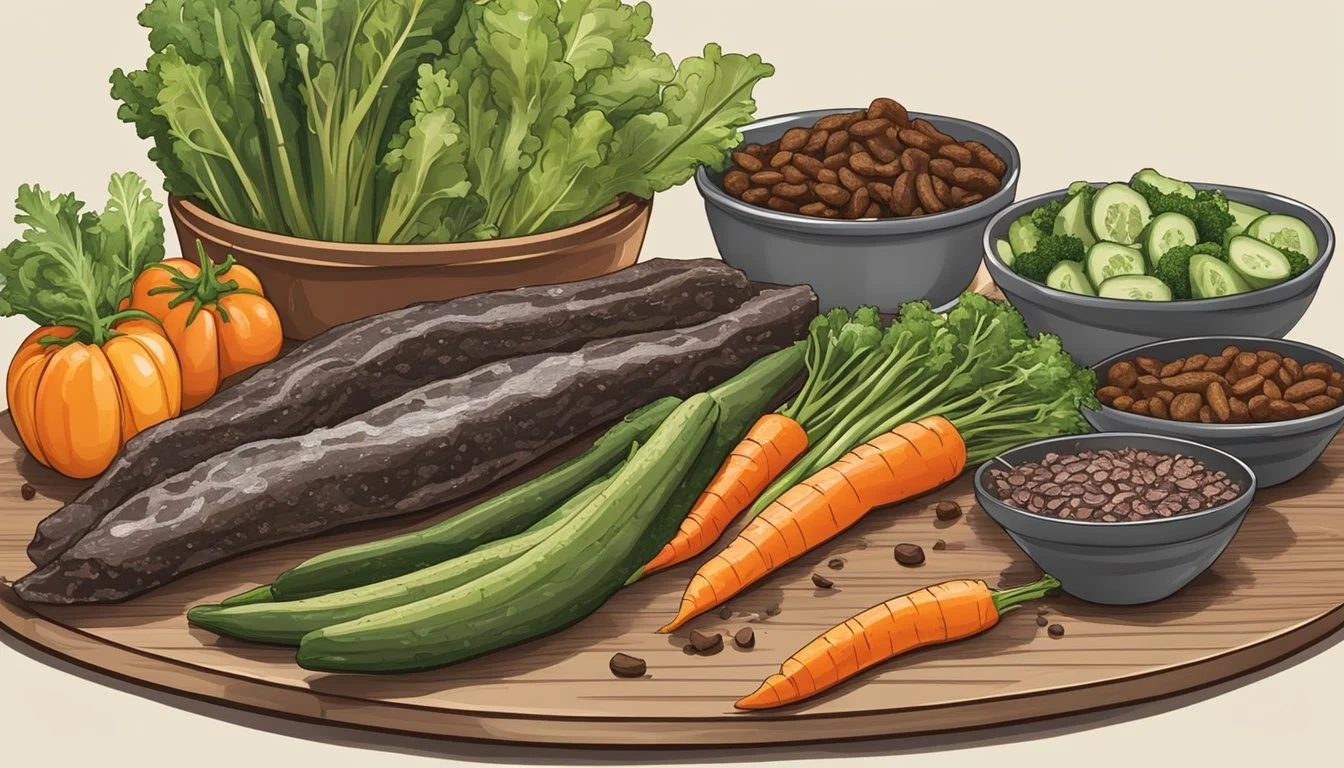Biltong vs Jerky Carnivore Diet
Key Differences and Benefits
When following the carnivore diet, enthusiasts often seek convenient, protein-rich snacks to meet their nutritional goals. Biltong and jerky, both made from dried meat, stand out as popular choices. Biltong offers a higher fat content and softer texture, while jerky tends to be leaner and chewier. These differences arise from their preparation methods: biltong is air-dried and cured with vinegar and spices, whereas jerky is typically dehydrated through low heat and smoking.
Nutritionally, both biltong and jerky provide substantial protein, essential for muscle maintenance and overall health on the carnivore diet. Biltong's higher fat content makes it a richer and more tender option, enhancing its flavor profile without added sugars. On the other hand, jerky's lean cuts result in a tougher texture and a smoky taste, often with varied seasoning options.
Choosing between biltong and jerky largely depends on personal preference and dietary needs. Biltong, with its minimal processing and rich taste, aligns well with those emphasizing natural, high-fat snacks. Jerky, being more accessible and varied in flavors, appeals to those seeking a simpler, protein-focused option on the go.
Historical Context
Biltong and jerky have rich histories tied to their geographical and cultural contexts. Understanding their origins provides insight into how these dried meats became staples in various diets, including the carnivore diet.
Origins of Biltong
Biltong originated in Southern Africa, specifically in South Africa, Zimbabwe, and Zambia. The indigenous people practiced drying meat as a preservation method long before European settlers arrived.
When Dutch settlers, also known as Boers, settled in the region during the 17th century, they adapted these methods. They introduced vinegar and spices, enhancing the flavor and shelf life of the dried meat. This evolution marked the creation of biltong as we know it today.
The traditional process involved marinating meat in a mixture of vinegar and spices, then air-drying it. This method allowed the Boers to preserve meat during their travels and hunting expeditions.
Jerky in Different Cultures
Jerky's roots can be traced back to the Quechua people of South America. Their method, known as "ch'arki," involved drying strips of llama or alpaca meat for preservation. This technique was essential for surviving long journeys in harsh environments.
In North America, Native American tribes also dried meat, often using bison. Their version of jerky included a smoking process to enhance preservation.
European settlers in both North and South America adopted these methods, integrating them into their own food preservation practices. Over time, jerky evolved into the lean, chewy snack popular today.
Each culture's approach to drying meat reflects its environment, available resources, and culinary traditions. This diversity highlights the adaptability and resilience of preserved meats across the globe.
Defining Biltong and Jerky
Biltong and jerky are both dried meat snacks, popular among those following a carnivore diet. Despite their similarities, they have distinct differences in preparation, taste, and nutritional profile.
What is Biltong?
Biltong is a type of cured meat originating from South Africa. It is made by air-drying beef, or sometimes game meat, that has been marinated in a mixture of vinegar and spices. The meat is typically sliced into thicker strips compared to jerky, which gives it a tender and chewy texture.
Biltong undergoes a curing process where the meat is soaked in salt and other seasonings to preserve it before drying. This method results in a rich and sometimes slightly tangy flavor. The fat content in biltong can vary but is generally higher than in jerky, contributing to its distinctive taste.
The air-drying process can take several days, and during this time, the meat's moisture is reduced significantly.
Understanding Jerky
Jerky, on the other hand, is made from lean cuts of meat that are sliced thin and marinated in a variety of seasonings before being dehydrated. The key preparation difference lies in how the meat is dried; jerky is often smoked or dried at low temperatures in an oven or dehydrator.
This method removes most of the fat, resulting in a drier and sometimes tougher final product. Jerky's flavor profile is frequently smoky, thanks to the dehydration process, which can include smoking the meat.
The lean nature and preparation technique make it a highly portable and long-lasting snack. Unlike biltong, jerky does not typically undergo a significant curing process aside from the marination. The emphasis on dehydration provides a different texture and taste experience.
Nutritional Profiles
Biltong and jerky are both high-protein snacks favored by those on the carnivore diet, but they differ in their nutritional content. This section explores specific differences in protein, carbohydrates, fats, and vitamins and minerals.
Protein Content
Biltong typically contains about 50 grams of protein per 100 grams, making it an excellent protein source. Jerky, on the other hand, often provides around 30-40 grams of protein per 100 grams. While both snacks are protein-dense, biltong generally has a higher protein concentration, which can be significant for individuals focusing on muscle maintenance and growth.
Carbs and Sugar
Biltong is low in carbohydrates, usually containing around 1 gram per 100 grams. Jerky can vary more in carb content due to added sugars and marinades. Some jerky products might have up to 5-10 grams of carbs per 100 grams. For those strictly limiting carbs, biltong may be the preferable choice.
Fat Content in Biltong and Jerky
Biltong generally contains about 5 grams of fat per 100 grams, which can vary depending on the cut of meat used. Jerky tends to be leaner with about 2-3 grams of fat per 100 grams. This makes biltong slightly higher in calories due to its fat content, but it also provides essential fatty acids that are vital for health.
Vitamins and Minerals
Both biltong and jerky are rich in B vitamins and iron. Biltong, with its slightly higher fat content, often retains more fat-soluble vitamins. Jerky’s processing might lead to slight losses in some vitamins, but it remains a good source of nutrients. Both snacks offer a dense nutrient profile, essential for those on restrictive diets like the carnivore diet.
Production and Preparation Methods
Biltong and jerky undergo distinct processes that shape their unique textures and flavors. Differences lie primarily in curing, drying, seasoning, and the types of meat cuts used.
Curing and Drying Processes
Jerky is typically cut very thin and cooked on a rack at a low temperature. This slow dehydration process cooks the meat while drying it. The goal is to remove moisture to ensure a longer shelf life.
Biltong, on the other hand, undergoes a different method. The meat is thicker and air-dried rather than cooked. A crucial step involves soaking the meat in vinegar, which helps in preservation and contributes to its distinctive taste and tender texture. While biltong usually dries over several days, jerky achieves its final form within hours.
Seasoning Techniques
Seasoning plays a significant role in defining the flavors of biltong and jerky. Jerky commonly features a smoky and robust taste due to the addition of spices like pepper, garlic, and occasionally, liquid smoke. The seasoning is often applied before the drying process, allowing the flavors to infuse deeply.
Biltong’s seasoning includes a mix of vinegar, salt, and spices like coriander. The vinegar-based marinade helps tenderize the meat, while the spices add a complex flavor profile. The use of minimal heat in biltong's preparation preserves the spice flavors, offering a more pronounced taste compared to jerky.
Cuts of Meat Used
The types of meat cuts used for biltong and jerky also differ. Jerky is typically made from lean cuts of meat. The focus on lean cuts helps achieve a chewy texture, suitable for longer drying periods and producing a tougher bite.
In contrast, biltong uses fattier cuts, contributing to a more flavorful and tender product. This choice affects the mouthfeel and taste, as higher fat content can enhance the richness of the meat. Traditionally, biltong includes beef but can also feature game meats balanced by the fat content.
These distinctions in production and preparation methods contribute significantly to the distinctive experiences of biltong and jerky, from texture to flavor.
Taste, Texture, and Quality
Biltong and jerky, two popular dried meat snacks, offer distinct experiences in terms of taste, texture, and quality. Preferences often depend on personal tastes and dietary needs.
Flavor Profiles
Biltong has a rich, savory flavor, often described as zesty due to the vinegar used in preparation. This gives it a tangy edge along with the traditional salt and spices.
Jerky, on the other hand, features a slightly sweet and smoky flavor from the marination and smoking process. It typically includes ingredients like soy sauce and brown sugar, adding a complex sweetness.
Texture Comparisons
Biltong is noted for its tender and moist texture, which comes from using thicker, fattier cuts of meat. It is often chewier and less tough than jerky, making it easier to bite through.
Jerky is generally tougher and drier. Its thin slices and the dehydration process create a more rigid texture that is chewed longer. This makes it a sturdier, though less tender, option.
Quality Considerations
The quality of biltong and jerky depends heavily on the meat cuts and preparation methods used. Biltong uses high-quality, fattier cuts which enhance both flavor and tenderness. Traditional preparation methods prioritize natural drying without artificial additives.
Jerky quality can vary with the use of leaner cuts, and sometimes additives or preservatives are included for extended shelf life. High-quality jerky brands focus on natural ingredients and slow cooking processes to maintain flavor integrity.
Consumption and Usage
Biltong and jerky are popular choices on carnivore and keto diets. These meat-based snacks offer convenience, nutritional benefits, and versatility in both snacking and meal preparations.
As Part of a Carnivore or Keto Diet
Both biltong and jerky align well with the carnivore and keto diets due to their high protein content and low carbohydrate levels. Biltong is typically made from fattier cuts of meat, making it appealing for those on keto who aim to consume higher fat ratios. Jerky, made from lean cuts, serves as a lower-fat option, yet still offers substantial protein.
The absence of sugars and minimal seasoning in biltong also makes it suitable for strict carnivore dieters. Some brands of jerky can contain added sugars, so it's critical to select options that fit the dietary guidelines. The animal-based nature of these snacks ensures they can be integrated seamlessly into both diet plans.
Snacks and Meal Preparations
When it comes to snacks, biltong and jerky are both portable and shelf-stable, making them ideal for quick bites throughout the day. Biltong’s softer texture allows it to be easily incorporated into a variety of dishes, such as omelets or salads, enhancing the flavor and protein content without requiring much preparation.
On the other hand, jerky, being chewier, is best suited for direct consumption. It's common in keto-friendly snack packs. For meal preparations, using biltong as a topping on cauliflower rice or bulked into avocado bowls can add an extra layer of richness. Jerky can be cut and mixed into scrambled eggs to create a protein-packed breakfast.
Pairing with Other Foods
Pairing these meat snacks with other foods can enhance the dietary experience. Biltong pairs excellently with teas or coffee, providing a balanced snack. Its rich flavor complements herbal teas such as chamomile or green tea. Combining biltong with cheese or cream-based dips also creates satisfying keto-friendly snacks.
Jerky can be paired with nuts or low-carb vegetables like celery sticks. Its smoky flavor can complement soft cheeses or be added to keto-friendly wraps for added texture. Both biltong and jerky make excellent companions to meat-based dishes, enhancing the overall meal experience for individuals following a carnivore or keto lifestyle.
Health and Dietary Considerations
Biltong and jerky offer distinct nutritional profiles that cater to various dietary needs and preferences. Key considerations include their carbohydrate content, use of preservatives, and potential allergens.
Low-Carb and Sugar-Free Options
For those on a low-carb diet, both biltong and jerky can be viable snack options. Biltong is typically lower in sugar compared to jerky, making it more suitable for individuals seeking no sugar or minimal sugar intake. This is important for people following strict low-carb or ketogenic diets.
Jerky, while still generally low in carbs, might contain added sugars depending on the brand and flavoring. It's crucial to check product labels to ensure they meet your dietary requirements. Both snacks are high in protein, which can aid in muscle maintenance and satiety.
Preservatives and Additives
Preservatives and additives are another area to consider. Biltong traditionally uses salt and vinegar for curing, which means it often contains fewer artificial preservatives. This natural curing process appeals to those who prefer snacks with minimal chemical additives.
Conversely, jerky may include various preservatives and flavor enhancers to prolong shelf life and improve taste. These can include added sugar, sodium nitrate, and artificial flavors. For consumers seeking cleaner, more natural products, biltong might be the preferred choice, but always review ingredient lists carefully.
Allergen Information
Potential allergens in biltong and jerky depend largely on added ingredients. Common allergens include soy, gluten, and dairy, particularly in flavored varieties. People with specific allergies should opt for plain versions and scrutinize ingredient labels.
Nut and seed-based spices might be present, posing risks for those with nut allergies. Recognizing these differences is essential for safe consumption, especially for individuals with sensitive dietary needs. It's wise to consult with a nutritionist if you have any dietary restrictions.
Storage and Shelf Life
Proper storage and understanding shelf life are crucial for enjoying high-quality biltong and jerky. This section covers ideal preservation techniques and how to determine freshness and quality to ensure safe consumption.
Optimal Preservation Techniques
To maintain the freshness of biltong and jerky, it is essential to control moisture levels and prevent exposure to air. Biltong, being fattier and softer, should be stored in a cool, dry place. An airtight container with a desiccant packet can help extend its shelf life. Jerky benefits from vacuum sealing to eliminate air that causes spoilage.
Refrigeration can also prolong the shelf life of both biltong and jerky. For long-term storage, freezing is an optimal method. When freezing, separate portions and use freezer-safe bags to maintain quality. Labeling packages with dates ensures timely consumption.
Maintaining proper temperature and humidity levels is key to preventing mold and bacterial growth. Regularly check stored items for changes in texture or smell, which may indicate spoilage.
Determining Freshness and Quality
Evaluating the freshness and quality of biltong and jerky involves checking several factors. Visually, look for any discoloration or mold, which indicates spoilage. High-quality biltong should appear slightly moist yet firm, while jerky should be dry but not brittle.
Smell is another indicator of freshness. Fresh biltong has a slightly tangy aroma due to vinegar used in its preparation. Jerky should emit a smoky or spiced scent depending on its marinade.
Texture is crucial. Biltong should be tender but not overly soft. Jerky should be chewy but not hard. Bite into the piece to check for consistent moisture levels. If the biltong feels excessively slippery or the jerky is too tough, it may no longer be fresh.
Use these sensory evaluations along with proper storage techniques to enjoy biltong and jerky at their best.
Choice and Personal Preference
When it comes to selecting between biltong and jerky on a carnivore diet, the decision largely hinges on factors like texture, flavor, and specific dietary needs.
Selecting the Right Product for You
Personal preference plays a significant role. Biltong typically offers a softer texture due to its air-drying process, which may appeal to those who prefer a tender chew. In contrast, jerky is often leaner and provides a tougher, more chewy experience.
Flavor is another key differentiator. Biltong features a pronounced vinegar taste from its curing process, which can be particularly appealing for those who enjoy tangy flavors. Jerky, on the other hand, tends to have a smokier profile, appealing to those who prefer robust, smoky flavors.
Both options should be evaluated for their ingredients. Higher-quality products with minimal additives are preferable. For instance, some biltongs might contain added fats, while jerkies might have more sugar or preservatives. Checking the label ensures that the product fits within the carnivore diet guidelines and personal health preferences.
Ultimately, testing different products can help determine which aligns best with individual taste and dietary goals.








